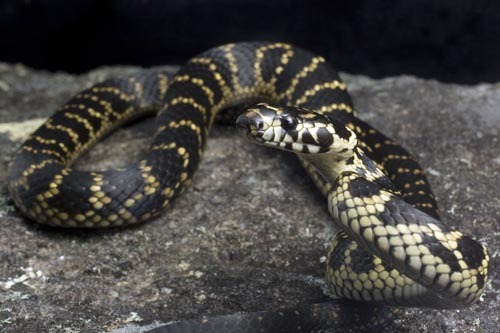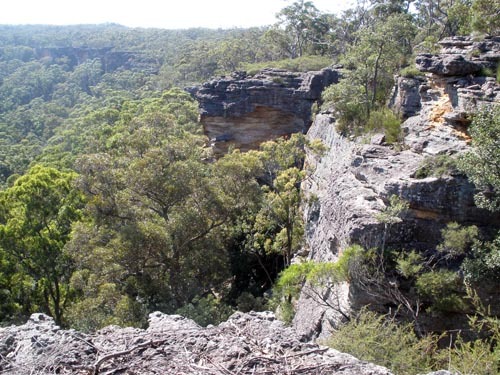When we think about conserving biodiversity, killing trees isn't a strategy that immediately leaps to mind. Yet, according to research that one of us (RMP) has been involved with over the past seven years, making habitats a little less green might sometimes be necessary to save species on the brink of extinction.
The animal in question is Australia's most endangered serpent, the broad-headed snake, pictured below. A beautiful creature, right? Even if you don't particularly like snakes, and it's a fair guess that many of you don't, you have to admit that the bold bands of yellow on black are . . . striking. There are perhaps 700 of these snakes left in the universe.
OK, before you can understand this species' predicament, you need to know a few basic things about its biology. First, the ability of snakes and other reptiles to function is closely tied to their body temperature, which in turn is tied in large part to the temperature of their surroundings. Broad-headed snakes live in eucalyptus forests in the vicinity of Sydney, where they take refuge under thin slabs of rock atop sandstone plateaus (also pictured below). They are extreme ambush predators, sitting under these rocks for weeks at a time, waiting for geckos (their principal prey) to happen by. Both the snakes and the geckos are active at night, so it's especially important that these rocks are warm in the late afternoon so that the snakes are warm enough to hunt after sunset. If the rocks ain't hot, them snakes cain't hunt.
Now, some ecological historians have hypothesized that in areas that haven't been completely paved over, the vegetation has been getting thicker over the past couple-hundred years. The argument goes like this: Aboriginal Australians used fire extensively as a tool to stimulate grass growth, a sort of bait for the kangaroos and wallabies that they hunted. All of these fires maintained a relatively open, grassy woodland for tens of thousands of years. The arrival of the English around 1800 caused the death and displacement of most of the indigenous population, and with it, the fire regimes. Believing fire to be detrimental to ecosystems and people, subsequent land managers have done their utmost to suppress wildfires. The end result: thicker forest cover. So far, though, the evidence for thicker forests has been mixed.
If the bush-encroachment argument is correct, then it means that many species adapted to relatively open conditions--like the broad-headed snake--have probably been losing habitat even in the most strictly protected national parks. Previous studies have shown that these heat-loving snakes don't occur in shaded habitat. In fact, the snakes are found only under the very hottest rocks, those that lots of direct sunlight. When vegetation grows up and shades rocks, snakes abandon them; when we experimentally cut the vegetation away, they return.
The most recent work on this project, soon to be published in the Journal of Applied Ecology, uses old-timey aerial photographs from the 1940s and 1970s along with satellite imagery from just a few years ago. Analysis of these images shows that the forest has indeed gotten thicker, the bare rock scarcer. It's a gloomy trend, as far as rock-dwelling reptiles are concerned.
The question is what to do about it. If the only goal is to ensure the survival of the broad-headed snake, then the answer is obvious: foresters need to head down to a few of the National Parks with either lighters or chainsaws and carefully start burning or lopping down some of the cover.
But of course things are never so simple. First of all, it is not clear what the land-management goal for these areas ought to be. What exactly are we trying to "conserve"? The ecosystem as it was before humans arrived? Before Europeans arrived? Some entirely new configuration? On what basis do we make this kind of decision? Saving the broad-headed snake would be wonderful; it's a handsome little reptile, after all. But it is also probably the best-studied species in the ecosystem, and its needs must be balanced against the needs of all the other species, most of which we know next-to-nothing about. If we start lighting more controlled fires, how much collateral damage will we cause to other animals and plants?
And then there's the human element. Prescribed burning is a touchy subject in Australia, mainly because eucalyptus trees combust like gasoline, and when bushfires get out of control, they can take entire towns with them. Some argue that more relatively cool, controlled burns would reduce fuel loads and the risk of dangerous fires, but wherever there's fire there's a risk of losing control. Not to mention that killing trees puts carbon into the atmosphere, which is something that we're generally trying to avoid these days. So should we just let the forest grow and wash our hands of the broad-headed snake? Treat it as an anachronism whose time has come to quietly bow out?
We tend to believe that habitat diversity, like species diversity, is a good thing, and naturally they tend to reinforce one another. Thus, we suspect that a few carefully controlled burns here and there, coupled with a hands-off policy elsewhere, would be best for maintaining a healthy and heterogeneous ecosystem without contributing too much to our greenhouse-gas problem. So in this case, we might be able to have our cake and eat it, too.
But we don't have any ironclad answers to the more general philosophical question about how to choose our conservation goals in the face of trade-offs. The remaining wildlands of the world are humanity's gardens, and like gardens they must be managed. And the reality is that they will have to be managed on a shoestring budget, on the basis of inadequate information, and with minimal ability to predict the full consequences of management actions. Increasingly, that's going to entail tough decisions about what to save and what to let go, a kind of ecological triage. Like trading trees for snakes. It will sometimes be a bitter pill to swallow, but we might as well get used to the idea.

The broad-headed snake Hoplocephalus bungaroides. Photograph by Jonno Webb.
